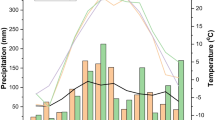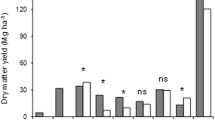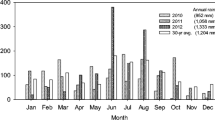Abstract
Demand for energy and the environmental consequences associated with fossil fuel emissions has created a need for alternative energy sources. To avoid conflict over the conversion of existing agricultural land from food production to fuel production, bioenergy crops could instead be cultivated on marginal land. This study compared the performances, biomass yield, tiller density, and lignocellulosic bioenergy feedstock composition of four prairie cordgrass populations with two-row spacings cultivated on a waterlog-prone marginal land, as well as three other bioenergy candidate crops used as controls: big bluestem, M. × giganteus, and switchgrass. Across all populations and spacings, annual biomass yield of prairie cordgrass was 13 Mg ha−1. Row spacing had significant impacts on prairie cordgrass productivity, with higher biomass yields observed in the 45 cm spacing than in the 90 cm spacing. Feedstock composition (cellulose, hemicellulose, ADL, and ash concentration) was not influenced by row spacing and did not deviate from expected values for growth on agricultural lands. However, biomass yields of the control species M. × giganteus and switchgrass planted in 45 cm spacing were higher than the prairie cordgrass. Our results provide evidence that prairie cordgrass could be a good energy crop with comparable biomass yield production to the energy crops M. × giganteus and switchgrass on waterlogged marginal land.





Similar content being viewed by others
Data Availability
Data and materials are available only by contacting the authors.
References
Pörtner HO, Roberts DC, Poloczanska ES, Mintenbeck K, Tignor M, Alegría A, Craig M, Langsdorf S, Löschke S, Möller V, Okem A (2022) Summary for policymakers. In: Pörtner HO, Roberts DC, Tignor M, Poloczanska ES, Mintenbeck K, Alegría A, Craig M, Langsdorf S, Löschke S, Möller V, Okem A, Rama B (eds) Climate change 2022: impacts, adaptation, and vulnerability. Cambridge University Press, Cambridge, pp 7–15
Milbrandt AR, Heimiller DM, Perry AD, Field CB (2014) Renewable energy potential on marginal lands in the United States. Renew Sust Energ Rev 29:473–481. https://doi.org/10.1016/j.rser.2013.08.079
Klingebiel AA, Montgomery PH (1961) Land-capability classification. Soil Conservation Service, U.S. Department of Agriculture, Washington, D.C.
Gopalakrishnan G, Cristina Negri M, Snyder SW (2011) A novel framework to classify marginal land for sustainable biomass feedstock production. J Environ Qual 40:1593–1600. https://doi.org/10.2134/jeq2010.0539
Khanna M, Chen L, Basso B, Cai X, Field JL, Guan K, Jiang C, Lark TJ, Richard TL, Spawn-Lee SA, Yang P (2021) Redefining marginal land for bioenergy crop production. GCB Bioenergy 13:1590–1609. https://doi.org/10.1111/gcbb.12877
Bockus WW, Shroyer JP (1998) The impact of reduced tillage on soilborne plant pathogens. Annu Rev Phytopathol 36:485–500
Stoof CR, Richards BK, Woodbury PB, Fabio ES, Brumbach AR, Cherney J, Das S, Geohring L, Hansen J, Hornesky J, Mayton H (2015) Untapped potential: opportunities and challenges for sustainable bioenergy production from marginal lands in the Northeast USA. Bioenergy Res 8:482–501. https://doi.org/10.1007/s12155-014-9515-8
Caudle KL, Maricle BR (2012) Effects of flooding on photosynthesis, chlorophyll fluorescence, and oxygen stress in plants of varying flooding tolerance. Trans Kans Acad Sci 115:5–18. https://doi.org/10.1660/062.115.0102
Tilman D, Socolow R, Foley JA, Hill J, Larson E, Lynd L, Pacala S, Reilly J, Searchinger T, Somerville C, Williams R (2009) Beneficial biofuels-the food, energy, and environment trilemma. Science 325:270–271. https://doi.org/10.1126/science.1177970
Valentine J, Clifton-Brown J, Hastings A, Robson P, Allison G, Smith P (2012) Food vs. fuel: the use of land for lignocellulosic ‘next generation’ energy crops that minimize competition with primary food production. GCB Bioenergy 4:1–19. https://doi.org/10.1111/j.1757-1707.2011.01111.x
Beale CV, Morison JI, Long SP (1999) Water use efficiency of C4 perennial grasses in a temperate climate. Agric For Meteorol 96:103–115. https://doi.org/10.1016/S0168-1923(99)00042-8
Mitchell RB, Schmer MR, Anderson WF, Jin V, Balkcom KS, Kiniry J, Coffin A, White P (2016) Dedicated energy crops and crop residues for bioenergy feedstocks in the central and eastern USA. Bioenergy Res 9:384–398. https://doi.org/10.1007/s12155-016-9734-2
Werling BP, Dickson TL, Isaacs R, Gaines H, Gratton C, Gross KL, Liere H, Malmstrom CM, Meehan TD, Ruan L, Robertson BA (2014) Perennial grasslands enhance biodiversity and multiple ecosystem services in bioenergy landscapes. Proc Natl Acad Sci USA 111:1652–1657. https://doi.org/10.1073/pnas.1309492111
Quinn LD, Straker KC, Guo J, Kim S, Thapa S, Kling G, Lee DK, Voigt TB (2015) Stress-tolerant feedstocks for sustainable bioenergy production on marginal land. Bioenergy Res 8:1081–1100. https://doi.org/10.1007/s12155-014-9557-y
Mobberley DG (1953) Taxonomy and distribution of the genus Spartina. Iowa State Coll J Sci 30:471–574
Stubbendieck JL, Hatch SL, Butterfield CH (1992) North American range plants. University of Nebraska Press, Lincoln
Weaver JE (1954) North American prairie. Johnsen Publishing Company, Lincoln
Bonilla-Warford CM, Zedler JB (2002) Potential for using native plant species in stormwater wetlands. Environ Manage 29:385–394. https://doi.org/10.1007/s00267-001-0032-0
Kim S, Rayburn AL, Voigt T, Parrish A, Lee DK (2012) Salinity effects on germination and plant growth of prairie cordgrass and switchgrass. Bioenergy Res 5:225–235. https://doi.org/10.1007/s12155-011-9145-3
Guo J, Thapa S, Voigt T, Rayburn AL, Boe A, Lee DK (2015) Phenotypic and biomass yield variations in natural populations of prairie cordgrass (Spartina pectinata Link) in the USA. Bioenergy Res 8:1371–1383. https://doi.org/10.1007/s12155-015-9604-3
Greef JM, Deuter M, Jung C, Schondelmaier J (1997) Genetic diversity of European Miscanthus species revealed by AFLP fingerprinting. Genet Resour Crop Evol 44:185–195. https://doi.org/10.1023/A:1008693214629
Hodkinson TR, Renvoize S (2001) Nomenclature of Miscanthus × giganteus (Poaceae). Kew Bull 56:759
Heaton EA, Dohleman FG, Miguez AF, Juvik JA, Lozovaya V, Widholm J, Zabotina OA, Mcisaac GF, David MB, Voigt TB, Boersma NN (2010) Miscanthus: a promising biomass crop. Adv Bot Res 56:75–137. https://doi.org/10.1016/B978-0-12-381518-7.00003-0
Pyter R, Voigt T, Heaton E, Dohleman F, Long S (2007) Growing giant miscanthus in Illinois. University of Illinois Extension, Urbana-Champaign
Miguez FE, Villamil MB, Long SP, Bollero GA (2008) Meta-analysis of the effects of management factors on Miscanthus × giganteus growth and biomass production. Agric For Meteorol 148:1280–1292. https://doi.org/10.1016/j.agrformet.2008.03.010
Lewandowski I, Clifton-Brown JC, Scurlock JMO, Huisman W (2000) Miscanthus: European experience with a novel energy crop. Biomass Bioenerg 19:209–227. https://doi.org/10.1016/S0961-9534(00)00032-5
Parrish DJ, Fike JH (2005) The biology and agronomy of switchgrass for biofuels. Crit Rev Plant Sci 24:423–459. https://doi.org/10.1080/07352680500316433
Wright L, Turhollow A (2010) Switchgrass selection as a “model” bioenergy crop: a history of the process. Biomass Bioenerg 34:851–868. https://doi.org/10.1016/j.biombioe.2010.01.030
Barney JN, Mann JJ, Kyser GB, Blumwald E, Van Deynze A, DiTomaso JM (2009) Tolerance of switchgrass to extreme soil moisture stress: ecological implications. Plant Sci 177:724–732. https://doi.org/10.1016/j.plantsci.2009.09.003
Sanderson MA, Reed RL, Ocumpaugh WR, Hussey MA, Van Esbroeck G, Read JC, Tischler CR, Hons FM (1999) Switchgrass cultivars and germplasm for biomass feedstock production in Texas. Bioresour Technol 67:209–219. https://doi.org/10.1016/S0960-8524(98)00132-1
Griffith AP, Epplin FM, Fuhlendorf SD, Gillen R (2011) A comparison of perennial polycultures and monocultures for producing biomass for biorefinery feedstock. Agron J 103:617–627. https://doi.org/10.2134/agronj2010.0336
Hong CO, Owens VN, Lee DK, Boe A (2013) Switchgrass, big bluestem, and indiangrass monocultures and their two-and three-way mixtures for bioenergy in the Northern Great Plains. Bioenergy Res 6:229–239. https://doi.org/10.1007/s12155-012-9252-9
Boe A, Keeler KH, Normann GA, Hatch SL (2004) The indigenous bluestems of the western hemisphere and gambagrass. In: Moser LE, Burson BL, Sollenberger LE (eds) Warm-season (C4) grasses. American Society of Agronomy/Crop Science Society of America/Soil Science Society of America, Madison, pp 873–908
Boe A, Springer T, Lee DK, Rayburn AL, Gonzalez-Hernandez J (2013) Underutilized grasses. In: Saha M, Bhandari HS, Bouton JH (eds) Bioenergy feedstocks: breeding and genetics. Wiley, New York, pp 173–205
Lee DK, Parrish AS, Voigt TB (2014) Switchgrass and giant Miscanthus agronomy. In: Shastri Y, Hansen A, Rodríguez L, Ting KC (eds) Engineering and science of biomass feedstock production and provision. Springer, New York, pp 37–59
Muir JP, Sanderson MA, Ocumpaugh WR, Jones RM, Reed RL (2001) Biomass production of ‘Alamo’ switchgrass in response to nitrogen, phosphorus, and row spacing. Agron J 93:896–901. https://doi.org/10.2134/agronj2001.934896x
Foster JL, Guretzky JA, Huo C, Kering MK, Butler TJ (2013) Effects of row spacing, seeding rate, and planting date on establishment of switchgrass. Crop Sci 53:309–314. https://doi.org/10.2135/cropsci2012.03.0171
U.S. Department of Agriculture, Natural Resources Conservation Service. National soil survey handbook, title 430-VI. https://directives.sc.egov.usda.gov (accessed 5 November 2022).
Endres TJ (2003) Soil Survey of Champaign County, Illinois. U.S. Department of Agriculture, Natural Resources Conservation Service in cooperation with the Illinois Agricultural Experimental Station.
Maughan M, Bollero G, Lee DK, Darmody R, Bonos S, Cortese L, Murphy J, Gaussoin R, Sousek M, Williams D, Williams L (2012) Miscanthus × giganteus productivity: the effects of management in different environments. GCB Bioenergy 4:253–265. https://doi.org/10.1111/j.1757-1707.2011.01144.x
Undersander DJ, Mertens DR, Thiex NJ (1993) Total ash in forage. Forage analysis procedures, National Forage Testing Association, Omaha, NE.
Guo J, Thapa S, Voigt T, Owens V, Boe A, Lee DK (2017) Biomass yield and feedstock quality of prairie cordgrass in response to seeding rate, row spacing, and nitrogen fertilization. Agron J 109:2474–2485. https://doi.org/10.2134/agronj2017.03.0179
Lee MS, Wycislo A, Guo J, Lee DK, Voigt T (2017) Nitrogen fertilization effects on biomass production and yield components of Miscanthus × giganteus. Front Plant Sci 8:544. https://doi.org/10.3389/fpls.2017.00544
Lee MS, Mitchell R, Heaton E, Zumpf C, Lee DK (2019) Warm-season grass monocultures and mixtures for sustainable bioenergy feedstock production in the Midwest, USA. Bioenergy Res 12:43–54. https://doi.org/10.1007/s12155-018-9947-7
Lee DK, Boe A (2005) Biomass production of switchgrass in central South Dakota. Crop Sci 45:2583–2590. https://doi.org/10.2135/cropsci2005.04-0003
Boe A, Owens V, Gonzalez-Hernandez J, Stein J, Lee DK, Koo BC (2009) Morphology and biomass production of prairie cordgrass on marginal lands. GCB Bioenergy 1:240–250. https://doi.org/10.1111/j.1757-1707.2009.01018.x
Harper JL (1985) Modules, branches, and the capture of resources. In: Buss LW (ed) Jackson JBC. Population biology and evolution of clonal organisms. Yale University Press, New Haven, pp 1–33
Beaty ER, Engel JL, Powell JD (1978) Tiller development and growth in switchgrass. J Range Manag 31:361–365
Matlaga DP, Schutte BJ, Davis AS (2012) Age-dependent demographic rates of the bioenergy crop Miscanthus × giganteus in Illinois. Invasive Plant Sci Manag 5:238–248. https://doi.org/10.1614/IPSM-D-11-00083.1
McKendrick JD, Owensby CE, Hyde RM (1975) Big bluestem and indiangrass vegetative reproduction and annual reserve carbohydrate and nitrogen cycles. Agro-Ecosystems 2:75–93. https://doi.org/10.1016/0304-3746(75)90007-4
Wyman CE (1999) Biomass ethanol; technical progress, opportunities, and commercial challenges. Annu Rev Energy Environ 24:1899–2226. https://doi.org/10.1146/annurev.energy.24.1.189
Waramit N, Moore KJ, Heggenstaller AH (2011) Composition of native warm-season grasses for bioenergy production in response to nitrogen fertilization rate and harvest date. Agron J 103:655–662. https://doi.org/10.2134/agronj2010.0374
Anderson EK, Parrish AS, Voigt TB, Owens VN, Hong CH, Lee DK (2013) Nitrogen fertility and harvest management of switchgrass for sustainable bioenergy feedstock production in Illinois. Ind Crop Prod 48:19–27. https://doi.org/10.1016/j.indcrop.2013.03.029
Parrish AS, Lee MS, Voigt TB, Lee DK (2021) Miscanthus × giganteus responses to nitrogen fertilization and harvest timing in Illinois, USA. Bioenergy Res 14:1126–1135. https://doi.org/10.1007/s12155-021-10244-w
Vough LR, Marten GC (1971) Influence of soil moisture and ambient temperature on yield and quality of alfalfa forage. Agron J 63:40–42. https://doi.org/10.2134/agronj1971.00021962006300010014x
Nelson CJ, Moser LE (1994) Plant factors affecting forage quality. In: Fahey GC, Collins M, Mertens DR, Moser LE (eds) Forage quality, evaluation, and utilization. American Society of Agronomy/Crop Science Society of America/Soil Science Society of America, Madison, pp 115–154
Lanning FC, Eleuterius LN (1987) Silica and ash in native plants of the central and southeastern regions of the United States. Ann Bot 60:361–375. https://doi.org/10.1093/oxfordjournals.aob.a087456
Hoenig M, Baeten H, Vanhentenrijk S, Vassileva E, Quevauviller P (1998) Critical discussion on the need for an efficient mineralization procedure for the analysis of plant material by atomic spectrometric methods. Anal Chim Acta 358:85–94. https://doi.org/10.1016/S0003-2670(97)00594-1
Monti A, Virgilio ND, Venturi G (2008) Mineral composition and ash content of six major energy crops. Biomass Bioenergy 32:216–223. https://doi.org/10.1016/j.biombioe.2007.09.012
Lewandowski I, Clifton-Brown JC, Andersson B, Basch G, Christian DG, Jorgensen U, Jones MB, Riche AB, Schwarz KU, Tayebi K, Teixeira F (2003) Environment and harvest time affects the combustion qualities of Miscanthus genotypes. Agron J 95:1274–1280. https://doi.org/10.2134/agronj2003.1274
Hodgson EM, Lister SJ, Bridgwater AV, Clifton-Brown J, Donnison IS (2010) Genotypic and environmentally derived variation in the cell wall composition of Miscanthus in relation to its use as a biomass feedstock. Biomass Bioenergy 34:652–660. https://doi.org/10.1016/j.biombioe.2010.01.008
Lee DK, Owens VN, Boe A, Jeranyama P (2007) Composition of herbaceous biomass feedstocks. North Central Sun Grant Center, South Dakota State University, Brookings, SD
Funding
This work was supported by the USDA National Institute of Food and Agriculture and the University of Illinois at Urbana‐Champaign Hatch Project (1001878).
Author information
Authors and Affiliations
Contributions
Conceiving and designing the experiments: D.K. Lee, Santanu Thapa, and Moon-Sub Lee. Performing the experiments: Santanu Thapa, Moon-Sub Lee, and Jia Guo. Analyzing the data: Moon-Sub Lee and Santanu Thapa. Writing original draft preparation, review, and editing: Moon-Sub Lee, D.K. Lee, Santanu Thapa, Kayla M. Vittore, Dylan P. Allen, Ryan A. Boyd, and Jia Guo; All authors have read and agreed to the published version of the manuscript.
Corresponding author
Ethics declarations
Ethics Approval and Consent to Participate
There are no ethical issues associated with this manuscript.
Consent for Publication
The authors have the approval to publish from the Institutes.
Conflict of Interest
The authors declare no competing interests.
Additional information
Publisher's Note
Springer Nature remains neutral with regard to jurisdictional claims in published maps and institutional affiliations.
Rights and permissions
Springer Nature or its licensor (e.g. a society or other partner) holds exclusive rights to this article under a publishing agreement with the author(s) or other rightsholder(s); author self-archiving of the accepted manuscript version of this article is solely governed by the terms of such publishing agreement and applicable law.
About this article
Cite this article
Thapa, S., Vittore, K.M., Allen, D.P. et al. Finding Promising Candidates for Wet Growing Conditions: The Effect of Two Row Spacings on Biomass Production of Four Bioenergy Prairie Cordgrass Populations in a Wet Marginal Land. Bioenerg. Res. 16, 1556–1566 (2023). https://doi.org/10.1007/s12155-022-10544-9
Received:
Accepted:
Published:
Issue Date:
DOI: https://doi.org/10.1007/s12155-022-10544-9




